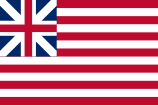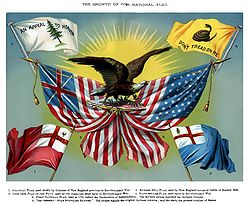
Grand Union Flag
Encyclopedia


Saint Patrick's Flag
Saint Patrick's Cross is a red saltire on a white field. In heraldic language, it may be blazoned Argent, a saltire gules. Saint Patrick's Flag is a flag composed of Saint Patrick's Saltire....
of Ireland
Ireland
Ireland is an island to the northwest of continental Europe. It is the third-largest island in Europe and the twentieth-largest island on Earth...
) in the canton.
In the first year of the American War for Independence, the Continental Congress
Continental Congress
The Continental Congress was a convention of delegates called together from the Thirteen Colonies that became the governing body of the United States during the American Revolution....
authorized the creation of a navy
Continental Navy
The Continental Navy was the navy of the United States during the American Revolutionary War, and was formed in 1775. Through the efforts of the Continental Navy's patron, John Adams and vigorous Congressional support in the face of stiff opposition, the fleet cumulatively became relatively...
. A new flag was required representing the Congress and fledgling nation, and distinguishing from the Red Ensign
Red Ensign
The Red Ensign or "Red Duster" is a flag that originated in the early 17th century as a British ensign flown by the Royal Navy and later specifically by British merchantmen. The precise date of its first appearance is not known, but surviving receipts indicate that the Navy was paying to have such...
flying from British vessels.
The Continental Colours were first hoisted on the Alfred, in Philadelphia on December 2, 1775, by Lt. John Paul Jones
John Paul Jones
John Paul Jones was a Scottish sailor and the United States' first well-known naval fighter in the American Revolutionary War. Although he made enemies among America's political elites, his actions in British waters during the Revolution earned him an international reputation which persists to...
. The event had been documented in letters to Congress. The Continental Colors were used by the American Continental forces as both naval ensign
Ensign
An ensign is a national flag when used at sea, in vexillology, or a distinguishing token, emblem, or badge, such as a symbol of office in heraldry...
and garrison flag through 1776 and early 1777.
It is not known for certain when, or by whom, the Continental Colors' design was created, though the flag could easily be produced by adding white stripes to the previous British Red Ensign
Red Ensign
The Red Ensign or "Red Duster" is a flag that originated in the early 17th century as a British ensign flown by the Royal Navy and later specifically by British merchantmen. The precise date of its first appearance is not known, but surviving receipts indicate that the Navy was paying to have such...
s. The Alfred flag has been credited to Margaret Manny
Margaret Manny
Margaret Manny was a milliner in colonial Philadelphia who made flags for the United States during the American Revolution.Manny began making jacks and ensigns for ships as early as December 1774...
.
It was widely believed that the flag was raised by George Washington
George Washington
George Washington was the dominant military and political leader of the new United States of America from 1775 to 1799. He led the American victory over Great Britain in the American Revolutionary War as commander-in-chief of the Continental Army from 1775 to 1783, and presided over the writing of...
's army on New Year's Day 1776 at Prospect Hill in Charlestown
Charlestown, Massachusetts
Charlestown is a neighborhood of Boston, Massachusetts, United States, and is located on a peninsula north of downtown Boston. Charlestown was originally a separate town and the first capital of the Massachusetts Bay Colony; it became a city in 1847 and was annexed by Boston on January 5, 1874...
(now part of Somerville
Somerville, Massachusetts
Somerville is a city in Middlesex County, Massachusetts, United States, located just north of Boston. As of the 2010 census, the city had a total population of 75,754 and was the most densely populated municipality in New England. It is also the 17th most densely populated incorporated place in...
), near his headquarters at Cambridge
Cambridge, Massachusetts
Cambridge is a city in Middlesex County, Massachusetts, United States, in the Greater Boston area. It was named in honor of the University of Cambridge in England, an important center of the Puritan theology embraced by the town's founders. Cambridge is home to two of the world's most prominent...
, Massachusetts
Massachusetts
The Commonwealth of Massachusetts is a state in the New England region of the northeastern United States of America. It is bordered by Rhode Island and Connecticut to the south, New York to the west, and Vermont and New Hampshire to the north; at its east lies the Atlantic Ocean. As of the 2010...
, and that the flag was interpreted by British observers as a sign of surrender. Some scholars dispute this traditional account, concluding that the flag raised at Prospect Hill was likely a British union flag
Union Flag
The Union Flag, also known as the Union Jack, is the flag of the United Kingdom. It retains an official or semi-official status in some Commonwealth Realms; for example, it is known as the Royal Union Flag in Canada. It is also used as an official flag in some of the smaller British overseas...
.
The name "Grand Union" is contemporary to Reconstruction-era historians, having been first applied to the Continental Colors by George Preble in his 1872 History of the American Flag.
The design of the Grand Union flag is similar to the flag of the British East India Company (BEIC). Indeed, certain BEIC designs in use since 1707 (when the canton was changed from the flag of England
Flag of England
The Flag of England is the St George's Cross . The red cross appeared as an emblem of England during the Middle Ages and the Crusades and is one of the earliest known emblems representing England...
to that of Great Britain
Kingdom of Great Britain
The former Kingdom of Great Britain, sometimes described as the 'United Kingdom of Great Britain', That the Two Kingdoms of Scotland and England, shall upon the 1st May next ensuing the date hereof, and forever after, be United into One Kingdom by the Name of GREAT BRITAIN. was a sovereign...
) were nearly identical, though the number of stripes varied from 9 to 15. That BEIC flags were potentially well known by the American colonists has been the basis of a theory of the origin of the Grand Union flag's design.
The Flag Act of 1777
Flag Acts (United States)
The Flag Acts are three laws which sought to define the design of the flag of the United States. Each is remarkably short, the shortest being a sentence of 32 words, and the longest being a title and two sentences of 117 words.- Flag Act of 1777 :...
authorized a new official national flag of a design similar to that of the Colors, with thirteen stars (representing the thirteen States
Thirteen Colonies
The Thirteen Colonies were English and later British colonies established on the Atlantic coast of North America between 1607 and 1733. They declared their independence in the American Revolution and formed the United States of America...
) on a field of blue replacing the British Union flag in the canton. The combined crosses in the union flag symbolized the union of the kingdoms of England and Scotland; the symbolism of a union of equal parts was retained in the new American flag.

